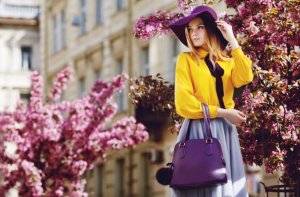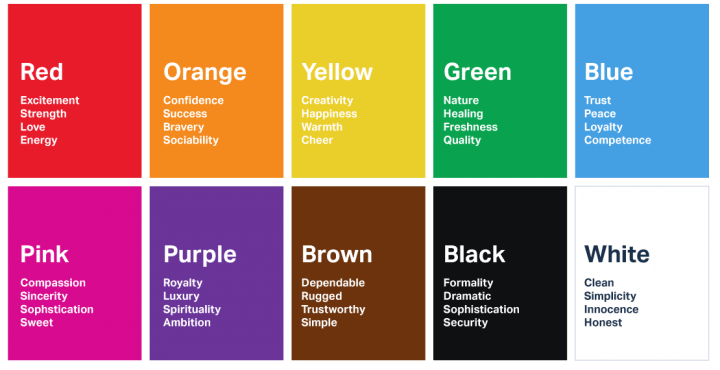What the Colors You Wear Say About You

The meaning of the colors you wear has much more of an effect on our daily lives than you may think. That’s why, although we’re unaware, our way of dressing can have a meaning according to the colors we use. Do you want to know more about it?
The Psychology of Color

According to a publication in Frontiers in Psychology, color has fascinated scholars for millennia. Because of this, we know the psychology of color, which links colors with emotional responses.
In other words, it investigates how colors affect us, as they can change our perception and alter our senses and emotions. It’s believed that colors have the power to improve memory and attention.
Also, it seems that colors have a great influence on the idea or image we have of a certain space or element. In fact, because of the emotional responses they cause us, they can also affect the way we dress.
We recommend you read: The Dangers of Wearing Very Tight Clothes
Use Colors to Your Advantage
Most people are concerned about the clothes they wear. According to a study published in the Journal of Personality and Social Psychology, this could be explained by the influence of dress on perceived and perceived social identity. In fact, it is also linked to romantic success and work results.
On the other hand, the choice of colors when dressing may be associated with mood. While there is no evidence that can fully confirm this, it is believed that the tendency to prefer some colors over others has to do with personality. Let’s see more about it.
The Meaning of Colors
Research has shown that colors influence your emotions and state of mind. They also interact with memory, arouse feelings and guide reason.
- Yellow is the color of the sun, light, happiness, optimism, wisdom, intelligence, mental agility, and success.
- Red represents fire, excitement, passion, enchantment, attraction, capture, and emotions.
- Sky blue reflects serenity and coldness, cleanliness, friendship, loyalty, relaxation of the mind and tranquility. Dressing in blue makes you feel more certain and reliable.
- Green represents freshness, freedom, healing, hope, wellness and peace. All positive things are associated with green, as well as happiness. With the color green, you can advance yourself, make progress, and become more positive.
- White represents purity, innocence, light, and peace. The color white helps you clarify whatever seems dark and unclear and lift up whatever is depressed.
- Pink is a loving color and associated with naivety and femininity.
- Gray represents resignation, old age, and sobriety. It also may remind you of gray matter or elegance.
- Gold represents wealth, glamour, brightness, wisdom and luxury.
- Silver reflects nobility, distinction and money.
- Orange represents stability, birth, development, expansion and tranquility. Additionally, you may associate it with spring and nature. The color orange is pure energy.
- Purple reflects changes, renovation, spirituality, meditation and concentration. The color purple is the color that converts negative energy into something positive.
- Black represents seduction, power, luxury, force, mystery, sadness, and pain. Black isn’t always a negative color. It’s also a marvelous color to dress in and combine with any other color.
- Brown represents laziness, sluggishness, ugliness. Although its meaning may not be so good, brown is a color that has a great presence around us and can be associated with many things.
Apply this psychology
In addition, colors also affect how we make common and simple decisions. Ever since birth, we’ve all had a favorite color. Almost all things come in various colors. This is a great advantage!
Also, keep in mind that your favorite color won’t always be the color you choose for any given object, and you should be aware that it won’t always look good with everything.
Check out: 7 Reasons You Should Visit a Psychologist

Combine colors according to your preferences, but keep color harmony in mind. For example, brown, gold, yellow, and orange represent autumn. However, brown combined with gray and black becomes very conservative and not very expressive.
There are colors that are more resistant to getting dirty, others more fit for the heat, and others that are perfect if you don’t want to be noticed.
Keeping in mind these ideas will improve your understanding. Using the psychology of color will help emphasize what you want to say and associate meaning with color.
All cited sources were thoroughly reviewed by our team to ensure their quality, reliability, currency, and validity. The bibliography of this article was considered reliable and of academic or scientific accuracy.
- Berger J., Heath C. (2008). Who drives divergence? Identity signaling, outgroup dissimilarity, and the abandonment of cultural tastes. Journal of personality and social psychology, 95(3), 593–607. Recuperado de: https://pubmed.ncbi.nlm.nih.gov/18729697/
- Elliot A. J. (2015). Color and psychological functioning: a review of theoretical and empirical work. Frontiers in psychology, 6(368), 1-8. Recuperado de: https://www.ncbi.nlm.nih.gov/pmc/articles/PMC4383146/
- Gray K., Schmitt P., Strohminger N., & Kassam K. S. (2014). The science of style: in fashion, colors should match only moderately. PloS one, 9(7), 1-3. Recuperado de: https://www.ncbi.nlm.nih.gov/pmc/articles/PMC4102554/
- Mentzel S. V., Schücker L., Hagemann N., & Strauss B. (2017). Emotionality of Colors: An Implicit Link between Red and Dominance. Frontiers in psychology, 8(317), 1-6. Recuperado de: https://www.ncbi.nlm.nih.gov/pmc/articles/PMC5337749/
- Perrett D. I., & Sprengelmeyer R. (2021). Clothing Aesthetics: Consistent Colour Choices to Match Fair and Tanned Skin Tones. i-Perception, 12(6), 1-22. Recuperado de: https://www.ncbi.nlm.nih.gov/pmc/articles/PMC8597069/
- Sidhu N., Qualter C., Higgs E., & Guo K. (2021). What colour should I wear? How clothing colour affects women’s judgement of other women’s body attractiveness and body size. Acta psychologica, 218, 1-8. Recuperado de: https://pubmed.ncbi.nlm.nih.gov/34029989/
This text is provided for informational purposes only and does not replace consultation with a professional. If in doubt, consult your specialist.








